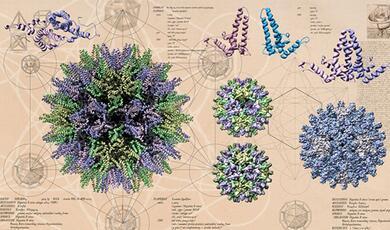Hormones, sex and animal passion: making pleasure out of necessity?
Share
- Details
- Text
- Audio
- Downloads
- Extra Reading
This lecture considers different patterns of male and female sexual behaviours, how hormones act to control them, and how and why the rigid link between sex and reproduction has been relaxed during evolution to include maintenance of social relationships. It also considers whether other animals have problems with impotence and if diversity in sexual orientation is unique to humans.
Download Text
Hormones, sex and animal passion: making pleasure out of necessity?
Professor Keith Kendrick
This lecture will explore similarities and differences between human sexuality and that of other mammals by considering answers to the following questions:
Q: Why do we need to have sex to reproduce?
Q: How do male and female mammals have sex?
Q: What are hormones and how do they work in the brain?
Q: What attracts the sexes to each other?
Q: Do other animals enjoy sex?
Q: How and why did social sex develop?
Q: Are problems in sexual orientation, deviation and dysfunction unique to humans?
Q: Why do we need to have sex to reproduce?
Having separate individuals to produce sperm (male) and eggs (female) represents an immediate 50% reduction of fitness in any species.
So why do it?
The simple answer to this is that for species in potentially challenging and changing environments (i.e. most of them) this step gives:
(a) Increased advantages for beneficial gene mutations since two different individuals contribute their genes to offspring.
(b) Increased inter and intra-sexual competition to help ensure that offspring are mainly produced by the fittest individuals most suited to survive.
In short sexual reproduction best allows species to adapt to changing environmental conditions through the process of both sexual and natural selection.
Q: How do male and female mammals have sex?
While males produce many trillions of sperm during a lifetime, females only produce a few hundred eggs - often far less than this taking into account pregnancies and lactation.
So males tend to adopt a strategy of spreading their seed indiscriminately and as widely as possible.
Females need to be more choosy in terms of deciding which male they want to father their offspring.
The evolution of human intelligence may even have resulted from females selecting for this trait in males to better guarantee survival of their offspring.
What do male mammals do?
They court the female for seconds or even days depending on her reproductive condition, readiness to have sex with them and interference from competing males. This usually involves direct eye contact, sniffing the female's genital area, flaunting erections, vocalising, tongue-protrusion and a load of invasion of 'personal space'.
Males after gaining an erection usually mount the female from the rear and may do this once or up to 10 times. Ejaculation is achieved after a series of pelvic thrusts. Typically it's all over in between 2 seconds and a few minutes. Only a few of the great apes (Bonobos, orang-utans and lowland Gorillas) frequently use the "missionary" position. The only other species reported to do this is the Stichbird - a songbird from Tiritiri Matangi, an island off the coast of New Zealand.
After ejaculation the sexes normally separate immediately and for around 2 to 15min the male cannot be sexually aroused whatever inducements are offered.
Subsequent willingness to engage in a further bout of sex is then dependent upon a number of factors:
Age
Level of female attraction and encouragement
Novelty of female (Coolidge effect)
Level of fitness/stress
Whether other males are in competition
- so the next ejaculation may be anything from a few minutes to many hours later.
The sex act for most male mammals is thus typically very quick and they are impotent for a variable period of time afterwards. Even for the human male, duration of sex after penetration is as little as 2 min (Kinsey, 1948).
There are notable exceptions however:
Dogs, pigs and some monkeys use a copulatory lock strategy where the sexes remain together for 30 mins to several hours.
Why are males of most species to quick?
Minimises risk of predation or interference from other males
- Sex is a risky business
Gives a better opportunity to move on rapidly to another female
- However monogamous and polygamous males are not more leisurely
Why are males of some species much slower?
Because they have less risk of predation
- So males from species that live in trees often take more time
Because, while they are engaged in sex, no other male can get access.
Do other male mammals masturbate?
Many male mammals touch or lick their genitals to achieve erection. Only in primates is masturbation to ejaculation seen. Species include: colobus, talapoins, macaques, baboons, mangabeys, mandrills, orang-utans, gorillas and chimpanzees.
Which parts of the brain are involved?
The brain regions controlling a male's sexual response are phylogenetically old and remarkably conserved across species. The critical areas for control of the integration of female sensory cues into the generation of sexual interest and performance reside right at the base of the brain in the hypothalamus. Stimulation of this area produces a hyper-sexed male when presented with a female but it does not seem to be involved in control of masturbation.
This region also receives inputs from parts of the brain dealing with emotion.
What do female mammals do?
Most female mammals have evolved ways of making sure that they are most attractive to males at the time they ovulate. All non-primate mammals have a period of behavioural oestrus that coincides with ovulation. They are unable and unwilling to have sex with a male at other times. Some species, such as rabbits, have refined this even further by only ovulating when they have sex - "reflex ovulators".
Female primates can have sex with males at all times but advertise ovulation by physical signs, such as sex skin swelling/colouring, odours, or by greater willingness to have sex. However, the human female, Bonobos and some monogamous New World primates do not physically advertise ovulation except by increased willingness to have sex. Failure of females to advertise ovulation may keep a male around for protection, resource provision or parental care - i.e. it pays to keep him guessing whether he is, or is not, the dad!
Females sexually attracted to males also engage in a wide variety of courtship displays to encourage their attentions. These are called "proceptive" behaviours. These are often subtler than males and can involve direct eye contact, nudging him, genital presentation, vocalising, tongue protrusion, ear wiggling - even engaging in sex with another female! When mounted by a male they show interest by not running away and often adopts reflexive postural adjustments (lordosis) to allow sex. These are called "receptive" behaviours.
Do other female mammals masturbate?
Yes they do, although it has been less extensively observed and mainly in the same non-human primates where males have also been observed to masturbate.
Which parts of the brain are involved?
Like the male, female sexual behaviour is controlled by parts of the hypothalamus at the base of the brain and the inputs they receive both from sensory and emotional centres. The main centres differ slightly from those controlling male sexual behaviour. Indeed, stimulating some regions involved in male sex can actually inhibit female sexual responses. So the brain mechanisms controlling male and female sexual responses can be mutually opposed.
Q: What are hormones and how do they work in the brain?
Sex hormones - androgens, oestrogens and progestagens - are present to a variable degree in both sexes. They are produced not only by the ovaries and testes but also by the adrenal gland. They are small molecules that diffuse freely into all cells in the body and bind to receptor proteins in the cytoplasm and/or nucleus. They influence transcriptional changes in many genes through sex steroid response elements located in their promoter regions (i.e. their influences on cell function are quite slow >2h).
Another class of hormone, termed "NEUROSTEROIDS" has been identified in the brain and spinal cord. They can be produced from cholesterol or steroid precursors. These hormones can alter cell functions very quickly (<30 min) by modulating neurotransmitter receptors on the cell surface. They may also be important for nerve repair.
Examples: Pregnenolone
Dehydroepiandrosterone
Progesterone (which can act as a neurosteroid as well as a conventional steroid)
Where are sex hormones found in the brain?
They bind to cells in many of the "older" areas of the brain dealing with control of sex (hypothalamus), aggression and emotion (limbic system). However, neurosteroids can influence the activity of the majority of cells in the brain one way or another.
What are their main functions in the brain?
(1) To organise it so that an individual displays either male or female patterns of sexual behaviour
(2) To facilitate the process whereby appropriate sensory cues can trigger sexual arousal
(3) To facilitate performance of sex
(4) They also affect aggression, appetite, mood, attention, sleep, learning and memory
(5) Oestrogens can act to protect the brain against neurodegeneration.
The making of a male brain
The default sex in terms of development is the female. Indeed, it would have been Adam that was formed from Eve's rib! If a female egg is fertilised by sperm bearing a Y-chromosome a foetus develops testes, and testosterone turns a female brain into a male one.
While research, as well as our own experience, confirms that male and female brains function very differently, there are few gross structural differences (apart from a 10% size difference). However, there are some sexually dimorphic regions in the hypothalamus of both humans and some other mammals. It is clear though that the main differences between male and female brains reside in how they are wired-up and release and respond to different chemical transmitters.
How do hormones help us become sexually aroused by the opposite sex?
In the absence of sex hormones all male and female mammals experience some decline in interest in the opposite sex. In males this may take days or years with effects being reduced progressively in species with higher levels of neocortical development - i.e. the truly "cerebral" parts of the brain! The same evolutionary pattern is true for females although female primates continue to be sexually receptive (although not so interested in inviting sex) without ovaries.
By contrast, reversing any decline in sexual arousal or performance caused by insufficient hormonal levels using replacement treatments can take days or weeks. Simply raising hormone levels above normal usually has little, if any, impact on male sex drive or performance. Since females normally experience wide cyclical variations in hormone levels they are more sensitive to any such alterations.
So how do hormones influence adult sexual behaviour?
Hormones effectively do four main things:
(1) Make it easier for appropriate sensory cues to influence brain centres that stimulate a sexual response.
(2) Facilitate the making of appropriate motor actions during sex.
(3) Heighten awareness of sexually arousing sensory cues
(4) Help you remember who you have had sex with!
What they don't do is stimulate sex directly.
They alter the way sensory cues impact on chemical transmitter systems (e.g. noradrenaline, dopamine, serotonin) in parts of the brain controlling sexual arousal and behaviour.
Q: What attracts the sexes to each other?
The idea that we routinely go around making dispassionate conscious judgements about which most genetically perfect individual to have babies with is clearly ridiculous. The process of promoting your own genes is much less rational. To understand how the basic principles of sexual attraction work we need to be able to answer some key questions:
(1) Why are animals normally only sexually attracted to their own species?
(2) What attracts the sexes to one another?
(3) Why don't we find close relatives sexually attractive?
(4) What makes one individual more attractive than another?
There are certain established general principles that provide some answers to these questions:
Do opposites attract?
Contrary to popular opinion work on hundreds of different species, including humans, has concluded that opposites don't attract - we are all looking to pair off with other individuals just like ourselves. The more alike another individual is to you, the greater is their degree of genetic similarity - i.e. it's a good way to make sure your offspring carry as many of your genes as possible. Interestingly, couples with the greatest similarities tend to be more fertile. Animal work has shown that maximal attraction to others occurs when they vary by about 12.5% genetically - i.e. 1st cousins.
Clearly human legislators managed to get this right without the benefit of research!
Early learning and experience are important
For us and most other social mammals it is clear that learning plays a key role in shaping sexual attraction. Early-life experiences are very important, particularly those reinforced by emotional ties - i.e. parents, siblings etc. This may be how we end up being attracted by individuals that look and act like ourselves - our nearest relatives look like us and share a high proportion of our genes.
So why isn't incest more common?
Firstly "constant social familiarity in early life breeds subsequent sexual contempt" - this is the "Westermarck hypothesis"(1891). Human examples are failure of child marriages - kim-pua - and absence of sexual relationships between children raised together in a Kibbutz. Sexual contact between offspring of Barbary macaques and caretakers is also absent irrespective of whether the caretakers are related.
The immune system also plays a role in attraction
We, and mice, are attracted to individuals with dissimilar immune complexes (particularly the major histocompatibility complex). Close relations are likely to have a similar MHC complex. We can smell if an individual has the same or a different MHC complex. This helps guarantee that offspring have a good immune system. In humans this was shown by measuring attraction to the smells of sweaty T-shirts.
Perception of body symmetry is also important
The more symmetrical the two halves of the body are (particularly the face) the more attractive an individual is supposed to be. In this case the broad assumption is that the more symmetrical an individual is the more likely they are to have a good genes.
What determines attraction between the sexes?
Male mice need pheromonal signals from a female to activate the gene TRP2 in the nose. Without this gene they have sex indiscriminately with both sexes and do not fight males. We and other animals quickly learn to use our senses to tell the differences between features that distinguish males from females. Male rats and mice learn to be attracted by the smell of urine from a sexually receptive female after having only had sex once! Lionesses are attracted to males with large dark brunette manes.
The extent to which our genes determine whether key physical features in the opposite sex trigger sexual responses is debatable. The perfume industry clearly holds out the hope that a specific chemical odour will promote an immediate sexual response by activating the human equivalent of a TRP2 gene!
It seems safer to conclude that learning plays an important role in determining attraction in humans. Indeed, cultural values can dramatically change what features we regard as attractive.
and finally:
Females tend to take many more factors into account than males in deciding if an individual is attractive. This is one way that females can make extra sure that they invest their valuable eggs wisely!
Q: Do other animals enjoy sex?
The male:
The high level of the male sex drive, and the physical paroxysms they display when ejaculating, make it easy to imagine that sex is highly pleasurable. Indeed, in all male mammals examined, sexual arousal, or having sex, activates the parts of the brain that control reward. Males will also work very hard to get access to females!
What about females?
It is often claimed that only human females experience orgasm. Many female mammals do seem as if having sex is simply accepting the inevitable and rush off when the male is finished. Appearances are however very deceiving in this case:
Orgasm is not unique to the human female occurs in a number of other primate species (chimpanzees, rhesus and stumptail macaques). All female primates have a clitoris that, in some species, is capable of erection. The stumptail macaque has a distinctive facial expression during climax although the primatologist, de Waal, claims this only happens on one in every six occasions!
Even with the large number of species where the female shows no peripheral evidence of an orgasmic response, sex does activate the parts of the brain controlling reward. Also, females will often actively seek out males until they receive an ejaculation. Receipt of multiple ejaculations may be a partial turn off since this can reduce the period of sexual receptivity - in sheep for example.
Perhaps one might regard female enjoyment of sex in most mammals as being akin to the relief obtained by scratching an annoying itch, but even this is pleasurable!
Is there such a thing as prostitution in other species?
In a wide variety of species, particularly primates, females can reward males with sex as a result of receiving gifts (mainly food or some other resource) within existing relationships. Having sex with a complete stranger for gain has only been documented in a single species: The Penguin! Here females within an existing relationship with a male will have sex with other strange males for payment in stones - a much sought-after resource for nest building!
Q: How and why did social sex develop?
All males are equipped to have sex at any time. The development of social sex is mainly about how and why female primates released their ability to have sex from rigid control by their ovaries.
The how is relatively straightforward:
(1) The brain circuitry controlling ovulatory cycles by influencing pituitary hormone release became less integrated with that controlling the female's sexual response.
(2) This allowed hormonal influences on sexual receptivity to be reduced
(3) Brain regions controlling sexual arousal, while retaining some degree of hormonal sensitivity, have become less involved with those controlling sexual receptivity.
The why is more difficult:
(1) One could view the whole evolution of this trait as a method whereby females could retain and control male interest and gain more resources from them.
(2) Equally one could view it as a way of reducing levels of male aggression within primate social groups - the "make love not war scenario"
(3) Another more hedonistic possibility might be termed the "pleasure principle" - Sex can be enjoyable so why limit it to a couple of days a month.
The simplest suggestion is that it is a variable contribution from all three. Perhaps the most interesting animal species to consider when trying to find an answer to this question, is the Bonobo.
Hominid evolution diverged from that of this great ape 6 million years ago, but many consider it to be the best representative of the common ancestor for modern apes and humans. Bonobos are peaceful, forest dwelling animals where females are generally the more dominant sex - although males don't get involved in parenting! Like many other species, females are more overtly social and form the strongest bonds.
However, unlike other species at the time of sexual maturity the males stay at home while the females leave to find another group in which to reproduce. They are definitely not monogamous and are characterised by an amazing capacity for sex in pretty much every possible combination.
Two observations from Bonobos are of key relevance in considering why female primates may have evolved social sex:
(1) Female Bonobos have ended up being dominant over males and levels of male aggression are low - so social sex may be a female strategy to control them.
(2) These animals usually have sex before other activities that might lead to conflict
i.e. sex is not a way of resolving an argument it is a way of avoiding having one in the first place
An interesting aside to this is that Bonobos, like other species, rarely have sex with close relations so perhaps, like us, they do argue more frequently with their relatives!
Q: Are problems in sexual orientation, deviation and dysfunction unique to humans?
So pretty much every aspect of the normal human heterosexual response has equivalents in some other animal species. Is this true of other aspects of human sexuality?
Are there animal homosexuals?
In most mammals sex play before or after sexual maturity is seen between members of the same sex. This is not homosexuality but practicing for the main event or letting off steam! However, there is also good evidence in both birds and mammals for homosexual partnerships of both a social and sexual nature.
Bruce Bagemihl, in his book Biological Exuberance (1999), has claimed evidence for this in nearly 200 species. This is probably an exaggeration and reflects social preferences for members of the same sex rather than true homosexuality.
The best documented example of homosexuality in another species with close parallels to humans is the sheep. Approximately 2% of male sheep show exclusive male sexual orientation - this compares with 2-4% in humans.
LeVay and Hamer (1991) found that the sizes of some hypothalamic regions in gay men more closely resembled those of women than heterosexual males. Some endocrine responses to sex hormones also more closely resemble those of females than heterosexual males.
There is a very similar pattern of brain and endocrine differences in 'gay' sheep.
In humans there is a continuing controversy as to whether such changes are cause or effect and whether genetic or experiential factors are responsible. In humans 65-75% of identical twins both have homosexual orientation compared with 29-33% of dizygotic ones - suggesting the possibility of a genetic component. Genetic concordance in the tail region of the X-chromosome (Xq28) between gay brothers is also a good predictor. Left-handed males or females are also more likely to be homosexual than right handed ones. However, birth order (how many brothers you have), absent or distant fathers, close mother-son relationships have also been shown to have effects.
In sheep the jury is out on this issue. Being reared in all male groups after weaning may contribute, but homosexual orientation can still occur in male sheep kept with females.
Are paraphilias unique to humans?
There are obviously some serious definition problems in considering this issue.
Do other animals commit rape?
Instances of what look like gang-rape of a female by males have been reported in Mallards. Here the female may actually die of injuries received. Groups of male dolphins have been reported to hi-jack and virtually imprison females for long periods to have forced sex.
Amongst primates so called "forced copulations" have also been reported in orang-utans (mainly by subordinate males) and in some macaques. They are quite rare however. There is also some evidence for experimentally induced "zoophilia" in animals.
In sheep and goats cross-species fostering produces animals that prefer to socialise and mate with members of their foster-mother's species. The effect is much stronger and apparently irreversible in males and seems to be entirely dependent upon the mother's influence.
Such sexual interest in members of another species has not been reported in normally reared animals, even when kept in close proximity to them. There are no well-documented examples of other paraphilias in animals - including paedophilia.
It is possible that some domestic animals and monkeys develop fetishes since sex with objects can be observed. Indeed, both rodents and men can learn to be sexually aroused by neutral objects and environments very quickly if given the right incentive. Sex with consenting juveniles can be observed in Bonobos but this cannot be construed as akin to paedophilia. It is possible that in most mammals, pre-pubertal individuals simply do not produce the right visual or smell cues to sexually attract adult members of the opposite sex.
While paraphilias are rare or absent in other animal species, animal studies do emphasise the importance of early experience on normal sexual development.
In humans the experiential factors identified as potential contributors to paraphilias do not normally apply to other animal species:
(1) Cultural suppression of the expression of juvenile sex play
(2) Early experience of sexual abuse by family members
(3) Problems with social interactions with the opposite sex
Paraphilias are reportedly absent in Yolngu - an aboriginal tribe in Northern Australia where juvenile sex play is encouraged but cultural taboos concerning adult sex and marriage are strong.
Do other animals experience sexual problems or loss of libido?
Any breeder of any domestic animal species knows that a proportion of males are basically low performers in the sexual drive or sperm count departments. The ability of males to engage in juvenile sex play with both males and females has also been shown to be important for normal adult sex behaviour in sheep.
The importance of early social attachments for developing normal sexual behaviour has also been shown in rhesus monkeys. Harlow and Harlow (1966) raised baby rhesus monkeys without maternal care and many individuals grew up either unable to mate with females or being very inept at doing it.
Stress is definitely a big turn-off for the sex drive of other animals - illustrated by animals low down in the dominance pecking order. Indeed, in some species, notably New World Primates, total reproductive suppression occurs in all group members except the dominant male and female.
Sex drive in other species also decreases with age.
Do other animals show psychological effects of menopause?
This has not really been studied since in many species individuals do not live much beyond their reproductive age. However, in seasonal breeders like sheep an equivalent to the male menopause has been reported. In these animals reduced testosterone levels during the non-breeding season lead to increased aggression and irritability.
What can we conclude from all this?
There are no major qualitative differences that make normal human male or female sexual responses unique in comparison with other mammals. This is not to deny of course that there are quantitative ones in terms of potential levels of sexual enjoyment and variety and dependence on hormones.
While there are clearly "hard-wired" elements underlying what triggers sexual attraction, arousal and performance, learning, particularly in early life, is also of great importance. Homosexual orientation is not unique to humans, cannot be simply reversed and is likely to be contributed to by a combination of genetic, hormonal and early-life experiences. An enhanced capacity for learning, emotional responses to abuse and repressive cultural sexual taboos has propagated the expression of paraphilias in humans.
Changes in females have promoted the evolution of social sex in primates as a strategy to better control male aggression and resource provision and has led to greater enjoyment of sex. The "make love not war" strategy seen in Bonobos, where females dominate males, may be the ultimate result of a social sex strategy where male aggression qualities are no longer required - however this has not resulted in the males helping look after the children!
Many scientists propose that the progressive demise of male dominance in our human culture results from females taking more direct control of their sexuality and resource provision. However, it is unlikely that environmental stability for humans will ever reach a point where males can be safely disposed of to regain 100% reproductive fitness with self-duplicating females!
Conflict between the sexes is a major survival tactic for most species and where one sex gains a temporary advantage one can be sure that the other will find a way to counteract it.
Illustrations of this arms race between the two sexes will be given in my next lecture.
© Keith Kendrick, 10 October 2002
This event was on Thu, 10 Oct 2002
Support Gresham
Gresham College has offered an outstanding education to the public free of charge for over 400 years. Today, Gresham College plays an important role in fostering a love of learning and a greater understanding of ourselves and the world around us. Your donation will help to widen our reach and to broaden our audience, allowing more people to benefit from a high-quality education from some of the brightest minds.


 Login
Login







